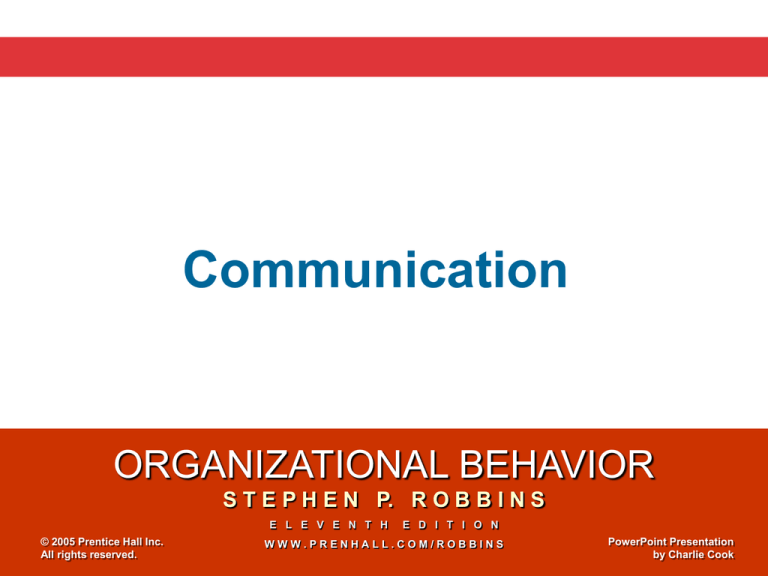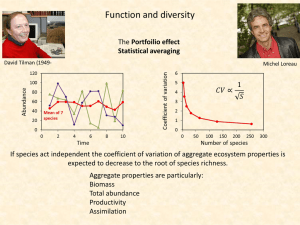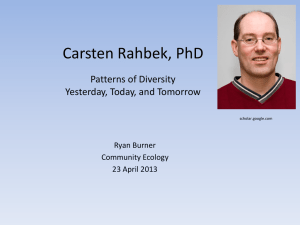
Communication
ORGANIZATIONAL BEHAVIOR
S T E P H E N P. R O B B I N S
E L E V E N T H
© 2005 Prentice Hall Inc.
All rights reserved.
E D I T I O N
WWW.PRENHALL.COM/ROBBINS
PowerPoint Presentation
by Charlie Cook
Functions of Communication
Communication
The transference and the understanding of meaning.
Communication Functions
1. Control member behavior.
2. Foster motivation for what is to be done.
3. Provide a release for emotional expression.
4. Provide information needed to make decisions.
The Elements and Communication Process Model
Communication Process
The steps between a source and a receiver that
result in the transference and understanding of
meaning.
The Communication Process
Channel
– The medium selected by the sender through which the
message travels to the receiver.
Types of Channels
– Formal Channels
• Are established by the organization and transmit
messages that are related to the professional activities of
members.
– Informal Channels
• Used to transmit personal or social messages in the
organization. These informal channels are spontaneous
and emerge as a response to individual choices.
Direction of Communication
Downward
Lateral
Upward
Interpersonal Communication
Oral Communication
– Advantages: Speed and feedback.
– Disadvantage: Distortion of the message.
Written Communication
– Advantages: Tangible and verifiable.
– Disadvantages: Time consuming and lacks feedback.
Nonverbal Communication
– Advantages: Supports other communications and provides
observable expression of emotions and feelings.
– Disadvantage: Misperception of body language or gestures
can influence receiver’s interpretation of message.
Intonations: It’s the Way You Say It!
Three Common Formal Small-Group Networks
NETWORKS
Criteria
Chain
Wheel
All Channel
Speed
Moderate
Fast
Fast
Accuracy
High
High
Moderate
Emergence of a leader
Moderate
High
None
Member satisfaction
Moderate
Low
High
Grapevine
Grapevine Characteristics
– Informal, not controlled by management.
– Perceived by most employees as being more
believable and reliable than formal communications.
– Largely used to serve the self-interests of those who
use it.
– Results from:
• Desire for information about important situations
• Ambiguous conditions
• Conditions that cause anxiety
Suggestions for Reducing the Negative
Consequences of Rumors
1. Announce timetables for making important decisions.
2. Explain decisions and behaviors that may appear
inconsistent or secretive.
3. Emphasize the downside, as well as the upside, of current
decisions and future plans.
4. Openly discuss worst-case possibilities—it is almost never
as anxiety-provoking as the unspoken fantasy.
Choice of Communication Channel
Channel Richness
The amount of information that can be transmitted
during a communication episode.
Characteristics of Rich Channels
1. Handle multiple cues simultaneously.
2. Facilitate rapid feedback.
3. Are very personal in context.
Information Richness of Communication
Channels
Low channel richness
High channel richness
Routine
Source: Based on R.H. Lengel and D.L. Daft, “The Selection of Communication Media as an Executive Skill,”
Academy of Management Executive, August 1988, pp. 225–32; and R.L. Daft and R.H. Lengel, “Organizational
Information Requirements, Media Richness, and Structural Design,” Managerial Science, May 1996, pp. 554–72.
Reproduced from R.L. Daft and R.A. Noe, Organizational Behavior (Fort Worth, TX: Harcourt, 2001), p. 311.
Nonroutine
Barriers to Effective Communication
Filtering
A sender’s manipulation of information so that it will
be seen more favorably by the receiver.
Selective Perception
People selectively interpret what they see on the
basis of their interests, background, experience, and
attitudes.
Information Overload
A condition in which information inflow exceeds an
individual’s processing capacity.
Barriers to Effective Communication (cont’d)
Emotions
How a receiver feels at the time a message is received
will influence how the message is interpreted.
Language
Words have different meanings
to different people.
Communication Apprehension
Undue tension and anxiety about oral
communication, written communication, or both.
Communication Barriers Between Men and
Women
Men talk to:
– Emphasize status,
power, and
independence.
– Complain that women
talk on and on.
– Offer solutions.
– To boast about their
accomplishments.
Women talk to:
– Establish connection
and intimacy.
– Criticize men for not
listening.
– Speak of problems to
promote closeness.
– Express regret and
restore balance to a
conversation.
Cross-Cultural Communication
Cultural Barriers
– Semantics
– Word connotations
– Tone differences
– Differences among
perceptions
Cultural Guide
– Assume differences
until similarity is
proven.
– Emphasize
description rather
than interpretation
or evaluation.
– Practice empathy.
– Treat your
interpretations as a
working hypothesis.
Communication Barriers and Cultural Context
High-Context Cultures
Cultures that rely heavily on
nonverbal and subtle
situational cues to
communication.
Low-Context Cultures
Cultures that rely heavily on
words to convey meaning in
communication.
Highvs.
LowContext
Cultures
TRANSACTIONAL
ANALYSIS
A model for explaining why and how:
– People think like they do
– People act like they do
– People interact/communicate with others
Transactional Analysis (TA) is a theory of personality, providing
a map of understanding self and others.
TA offers a theory of communication which can help us
understand how people express their personality through
behaviour and relationships.
Assumptions
People are OK: Every human being has worth value and dignity
Everyone has the capacity to think: We all can think for
ourselves. Therefore it is the responsibility of each of us to decide
what we want from life.
People make decisions about their life and these decisions
can be changed: People can change. We can achieve change not
only by insight, but by actively deciding to change old patterns of
behaviour
Transactions
A transaction consisting of a single stimulus and a single
response, verbal or non-verbal, is the unit of social action.
It is called a transaction because each party gains something
from it.
The transaction (or interaction) when two people meet is the
meeting place of six ego states (P-A-C plus P-A-C).
(P)
(C)
"Get out of bed lazybones.“
"Just a few more minutes."
"Come on, the early bird gets the biggest worm."
"But I'm so tired."
"You'll have plenty of rest after you're dead, now get up!"
Fundamental to TA is the notion that the personality
consists of three 'ego states':
Parent
Memories of our parent's thoughts, feelings and behaviors.
Thoughts, feelings, attitudes, behavioral patterns based on
messages or lessons learned from parents and other ‘parental’
or authoritarian sources
Adult
Current thoughts, feelings, and behaviors.
Thoughts, feelings, attitudes, behavioral patterns based on objective analysis
of information (data, facts)
Child
Childhood thoughts, feelings, and behaviors.
Thoughts, feelings, attitudes, behavioral patterns based on child-like emotions,
impulses, feelings we have experienced
Complementary transactions
The simplest kind of transaction is the complementary transaction,
where the arrows showing the communication of ego states with one
another are parallel.
'Look, you can't just go around
spending my hard-earned money on
new dresses whenever you feel like
it',
'No, you're right. I'm sorry, I
won't do it again.'
Crossed transactions
Type I (AA-CP)
An initial Adult-to-Adult stimulus has been
met with a Child-to-Parent response,
which causes most trouble in the world.
Type II (AA-PC)
The Adult-to-Adult stimulus is met with
a patronizing or pompous Parent-to-Child
response.
- What time do you have?
- There’s a clock on the wall,
why don’t you figure it
out yourself?
- How could you so cruel
like that?
- The boss asked me to do
so!
Type III (CP-AA)
The stimulus is from Child to Parent,
where someone is seeking sympathy,
but gets facts instead (Adult-toAdult).
Type IV (PC-AA)
The stimulus is from Parent to Child,
expecting compliance, the response is a
'smart alack' response, in the form of
a factual statement from Adult to
Adult.
Angular transactions
An angular transaction is a transaction in which the speaker
speaks as if to one ego state, but in fact covertly addressing
another.
If the response to the covert stimulus is from the ego state
covertly addressed, then the angular transaction was
successful, as shown in the graphic.
“Kamu punya potensi, dan
itu perlu digali… let’s
discuss”
Duplex transactions
In a duplex transaction, there are two separate transaction levels:
an overt, social level and a covert, psychological level.
Typically the social level would be in the verbal channel and
the psychological level in the non-verbal channel.
The social level
The psychological level
P
P
A
A
The verbal channel
C
C
The non-verbal channel
“How about coming up to my room
and listening to some music?”









